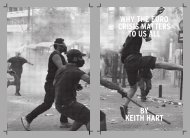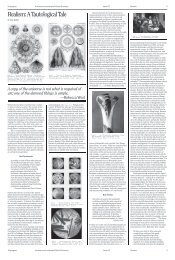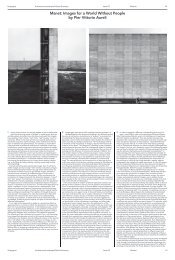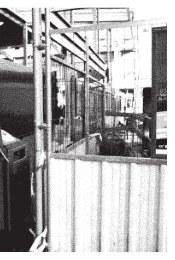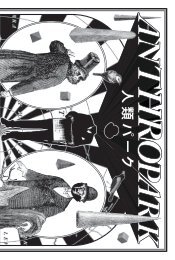Full Issue - Scapegoat
Full Issue - Scapegoat
Full Issue - Scapegoat
Create successful ePaper yourself
Turn your PDF publications into a flip-book with our unique Google optimized e-Paper software.
<strong>Scapegoat</strong> Architecture/Landscape/Political Economy<br />
<strong>Issue</strong> 01 Service<br />
4<br />
In the Presence of Another<br />
Being: A Conversation with<br />
Wendy Jacob<br />
by Gina Badger<br />
An exploration of Wendy Jacob’s recent work reveals key distinctions between different<br />
modes of group work. Under the aegis of Explorers Club, and then Autism Studio,<br />
Jacob has developed a working method informed not by service or collaboration, but<br />
by the communal structure of the club. A club is an affiliation among people with<br />
different skills, interests and backgrounds who, as a result, seek different outcomes of<br />
their membership. Both Explorers Club and Autism Studio consist of small, special<br />
interest groups devoted to the leisurely but rigorous indulgence of shared interests—<br />
including making YouTube videos, scavenging and collecting, and public space—and<br />
their memberships are constituted by artists and youth on the autism spectrum. The<br />
clubs’ activities consist of outings and meetings, and almost always have some form<br />
of public manifestation. While the clubs are attentive to the various ‘autisms’ of their<br />
members, this attention is not developed in order to pathologize them, but to develop<br />
communities of interest based on responses to the material world. The friendships and<br />
projects pursued in this context exist not despite, but across distinctions in ability and<br />
experience.<br />
Above<br />
Theodossios<br />
Issaias with<br />
Clovis Theilhaber,<br />
My Knees<br />
are Fine, 2009.<br />
Video stills.<br />
Image courtesy<br />
of the artist<br />
and Autism<br />
Studio.<br />
Jacob’s early career is characterized by her participation<br />
in the art collective Haha, which garnered recent art historical<br />
attention for Flood, its contribution to Mary Jane Jacob’s<br />
Culture in Action (1993). 1 In its last project together, a book<br />
entitled With Love from Haha (2008), the group affirmed its<br />
emphasis on “a specific place and a specific audience,” 2 against<br />
the increasing globalization of contemporary art. Projects like<br />
Flood—a hydroponic storefront garden that produced clean<br />
greens for seropositive people in the middle of the AIDS crisis,<br />
and Hotel Shorts (1996), which used public-access television<br />
to broadcast short, interview-based videos with residents of<br />
the Carillo Retirement Home in Santa Barbara—intervened<br />
critically in particular social situations in order to directly affect<br />
them, often involving their target audience in the production<br />
of the works. The care paid by Haha to the way in which the<br />
collective’s artworks became public is key to its politics, and is<br />
consistent with Jacob’s work post-Haha.<br />
In “Alluvial Deposits,” Brett Bloom’s contribution to With<br />
Love From Haha, “service” is defined as a mode of artistic<br />
production by which artists implicate themselves in the social<br />
and political fabric of the places they inhabit, creating projects<br />
that “can have multiple functions for people with different concerns,<br />
backgrounds, and levels of education and engagement.” 3<br />
Further, Bloom posits that service represents a way of working<br />
that is not subsumed by the reductive logic of experiencehawking<br />
capitalist political economies. Despite the similarities<br />
between Bloom’s conception of service and the operation of the<br />
club within Jacob’s work, there is a lot at stake in the distinction<br />
between the modes of group work suggested by these two<br />
terms. Service, with its implication of need, contradicts one of<br />
the priorities of both the Explorers Club and Autism Studio: to<br />
form communities of interest in excess of the clinical categories<br />
and lifestyles that normally enforce separation among their<br />
members.<br />
As a former student of Jacob’s and member of Autism Studio,<br />
I solicited her for insight into the mode of group work that<br />
links Haha to Explorers Club and Autism Studio. What follows<br />
is the result of our exchanges, which took place in April 2011.<br />
GB: The first iteration of Autism Studio was the<br />
Explorers Club, composed of yourself, Stefano Micali,<br />
and Addy <strong>Full</strong>er. When did you start this work?<br />
WJ: The Explorers Club started in the fall of 2008. But before<br />
there was an Explorers Club, Stefano and I made a number of<br />
installations with masking tape and gym mats in my studio<br />
at MIT. Stefano has a talent for naming things. He called our<br />
first installation “MIT Emporium.” He was twelve years old at<br />
the time.<br />
In the fall we left the studio to continue our work outdoors.<br />
Addy <strong>Full</strong>er, a student research assistant, joined us and<br />
we became the “Explorers Club.”<br />
GB: What were the founding motivations of Explorers<br />
Club?<br />
WJ: I had been talking with Stefano’s mother about my project<br />
rigging tightropes through buildings. She told me that Stefano<br />
was also interested in tightropes and had run string across his<br />
room, connecting the furniture.<br />
Stefano is autistic and is concerned about how spaces are<br />
ordered. Although his sight is perfectly fine, he has challenges<br />
integrating visual spatial information, particularly large, open<br />
spaces. He has devised tactics for framing or subdividing space<br />
such as wearing eyeglass frames, even though he doesn’t need<br />
corrective lenses, and running string around his room. Because<br />
Stefano and I were both altering spaces with lines, I invited him<br />
and his mother to my studio to do something with lines. It was<br />
an open-ended invitation, with no particular ideas about what<br />
might happen, or even of future work together.<br />
We ended up forming the Explorers Club and spent the<br />
next two years travelling all over Boston, laying down vinyl<br />
marking tape and temporarily restructuring the city with florescent<br />
orange lines. On one of our first outings, it became clear<br />
that we needed an identity. Stefano’s days are tightly scheduled<br />
with structured activities. So how to describe this activity?<br />
Stefano solved the problem by naming us the Explorers Club.<br />
In naming the activity, he also named us. We were not teachers<br />
and students or therapists and patients, but club members. And,<br />
as club members, we were all in it together.<br />
GB: What were the club’s principal activities?<br />
WJ: To explore. To lay down lines. To go to new locations. To<br />
visit every station in the subway system.<br />
GB: Why did you decide to expand the Explorers Club<br />
into Autism Studio, formalizing its methods and involving<br />
more people?<br />
WJ: With the Explorers Club, I was not interested in the pathology<br />
or condition of autism per se, but with the experience<br />
of being with a particular person (Stefano) and his particular<br />
way of organizing and experiencing the world. In thinking<br />
about the class, I wanted to see what could happen if a group<br />
of neurotypical students could re-imagine the physical world<br />
from the perspective of someone with autism. (Neurotypical is a<br />
term coined in the autistic community for someone not on the<br />
autism spectrum.) I was convinced that the exchange could be<br />
mutually beneficial and that new ways of thinking about space<br />
and communication might evolve from it.<br />
GB: How was the experience of teaching the Autism<br />
Studio “method?” For two consecutive years, you<br />
led Autism Studio as a semester-long course in MIT’s<br />
Visual Arts Program. How did it differ from one year<br />
to the next?<br />
WJ: In its first year, the class used autism as a point of departure<br />
for a broader investigation into the nature of experience.<br />
One student, Jackie Lee, worked with Clovis Bockstaele, a<br />
young, non-verbal autistic man. Their work culminated in a<br />
birthday party, where Jackie and Clovis tore paper together as<br />
an act of communication and fraternity. It was a beautiful project.<br />
In its second year, I built collaboration into the structure of<br />
the class and all the students worked with autistic partners.<br />
GB: The Explorers Club provides a model for collaboration<br />
between artists and non-artists—people with<br />
different interests, skill sets, and desired outcomes. Do<br />
you view this collaboration as a form of service? And<br />
does service imply a kind of longevity? How did this<br />
translate in Autism Studio, where students who participated<br />
in projects and semesters ultimately framed the<br />
duration of the interactions?<br />
Wendy Jacob with<br />
Stefano Micali,<br />
Explorer’s Club,<br />
2009. Image<br />
courtesy of the<br />
artist.<br />
WJ: I hesitate to call what we do “service.” Maybe “group works”<br />
is a better fit. Service implies a doing for, and doesn’t acknowledge<br />
the two-way aspect of the relationship. But to address<br />
your second question, I don’t think Autism Studio’s group<br />
works necessarily require longevity. A short-term collaboration<br />
can be as fruitful as a long-term one. For most of the students,<br />
their involvement was determined by the length of the<br />
semester. For others, the work has continued. Jackie, Gershon<br />
Dublon and Theo Issaias, for example, have all continued to be<br />
involved with Clovis and his family, two, three years after the<br />
studio formally ended.<br />
GB: How did you approach the families of Stefano,<br />
James Crawley, and Clovis?<br />
WJ: I had known Stefano and Clovis’s families for a while, and<br />
recently met James’s mother. By way of introduction, I invited<br />
the boys’ parents to meet with the class. During that initial visit,<br />
students and families paired themselves up. The families were<br />
an important part of the collaborations. We depended on them<br />
for guidance and interpretation.<br />
GB: In the iteration of Autism Studio that I participated<br />
in, we talked about not wanting to be another form<br />
of therapy or to offer some kind of cure. We didn’t<br />
imagine that we were experts on anything, and we<br />
weren’t necessarily interested in approaching autism<br />
as a pathology. Can you talk about how you conceptualized<br />
the activities of Autism Studio participants in<br />
contrast to the therapeutic routines of the families we<br />
worked with?<br />
WJ: Many autistic children have highly structured lives shaped<br />
in part by a cohort of therapists, teachers, and other specialists.<br />
The participants in Autism Studio met on a regular basis, becoming<br />
part of each family’s routine, at least for the duration of<br />
the semester. I never had ambitions, however, for the activities<br />
of the studio to be part of a larger therapeutic regime. I know<br />
that you, Gina, were interested in a particular therapy in which<br />
James was involved and incorporated aspects of it into your<br />
project. So that was an interesting crossover, though your use<br />
of that information had more to do with your own thinking and<br />
process than with supplementing James’s therapy.<br />
GB: When you presented on Explorers Club in the<br />
early days, I recall you saying something along the<br />
lines of sometimes you and Addy would plan activities<br />
that would play off of or exaggerate Stefano’s<br />
“autisms.” Can you expand on that (or correct me if I<br />
didn’t remember it right)?<br />
WJ: I think what’s important is that we weren’t approaching<br />
the Explorers Club as an experiment in behaviour modification.<br />
We weren’t trying make Stefano appear “less autistic,” but were<br />
interested in engaging with him as he was, with all his particular<br />
abilities and interests.<br />
GB: I guess what I meant was that you didn’t see any<br />
of Stefano’s behaviour as “symptoms” of his autism,<br />
as in something to be expunged. Instead you wanted<br />
to run with him, just trust and honour his ways of<br />
seeing and doing—even, or especially, when they<br />
diverged from the norm.<br />
Haha’s project Flood has garnered renewed attention<br />
in recent years. Perhaps this is because of an<br />
interest in service as a model for politically engaged<br />
art practices and the desire for models of locally based<br />
artworks that stand in stark contrast to the itinerant<br />
“art star” production encouraged by biennial culture.<br />
Can you talk about the relationship between Haha’s<br />
work and Autism Studio?<br />
WJ: With both Flood and the projects of Autism Studio there<br />
is a messiness of identity. Is it therapy? Education? Social work?<br />
In both cases, the answer is none of the above, and a very little<br />
bit of all of the above. Mostly, however, it is art. With Flood, we<br />
weren’t trying to change public policy or discover a cure. We<br />
were creating an indoor garden that provided clean greens to<br />
a limited number of people with HIV/AIDS. The project was<br />
different things to different people. For some it was a source of<br />
greens, for others it was a place to garden, socialize, or hang out.<br />
For others it was a curiosity: a patch of green in the middle of a<br />
grey Chicago winter.<br />
The focus on collaboration as a means of research is also<br />
central to both Autism Studio and Haha’s working process. It<br />
isn’t that two (or four) heads are better than one; it is more<br />
about what happens when people with different backgrounds<br />
<strong>Scapegoat</strong><br />
In the Presence of Another Being<br />
Wendy Jacob and Gina Badger<br />
4



